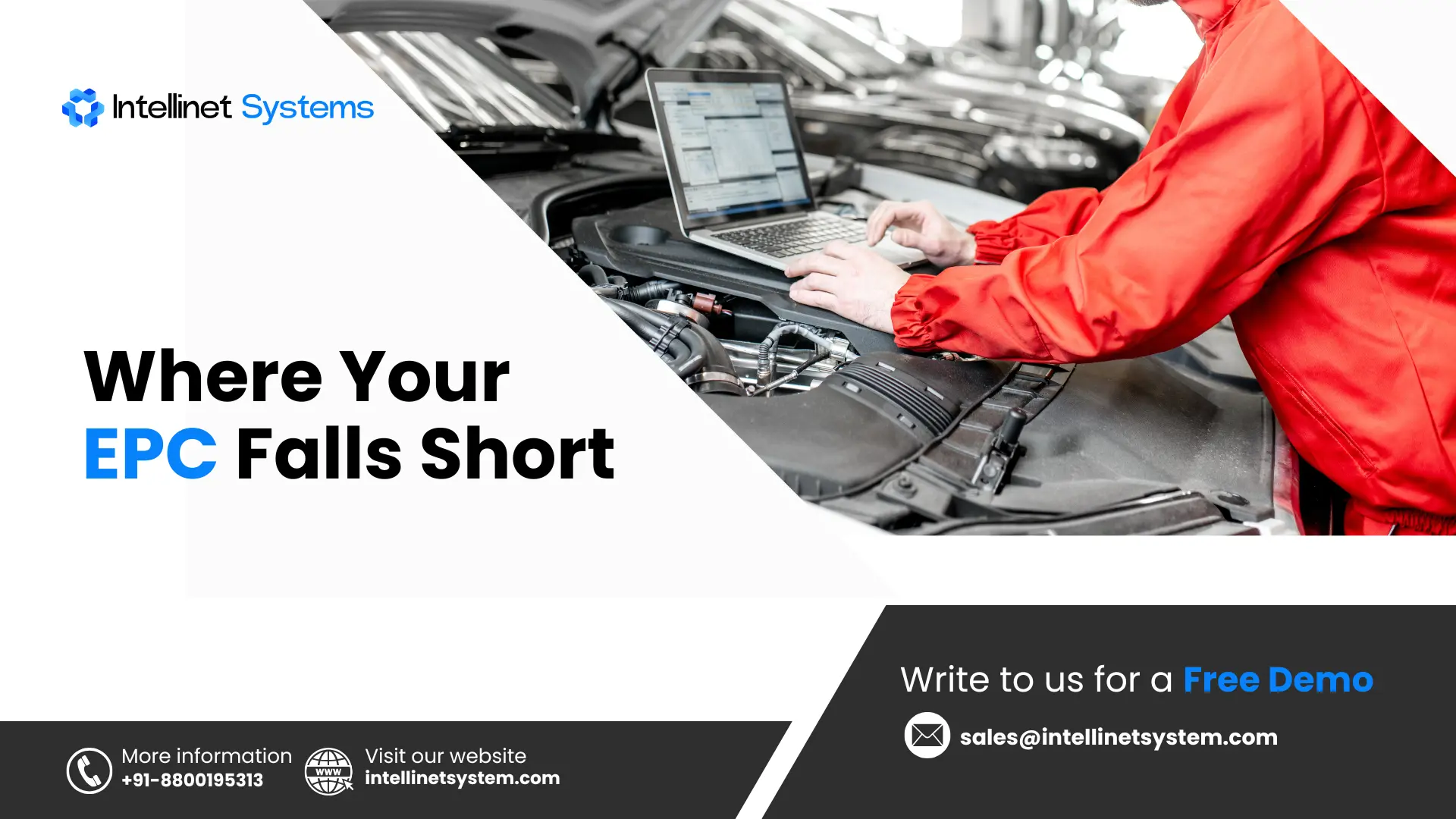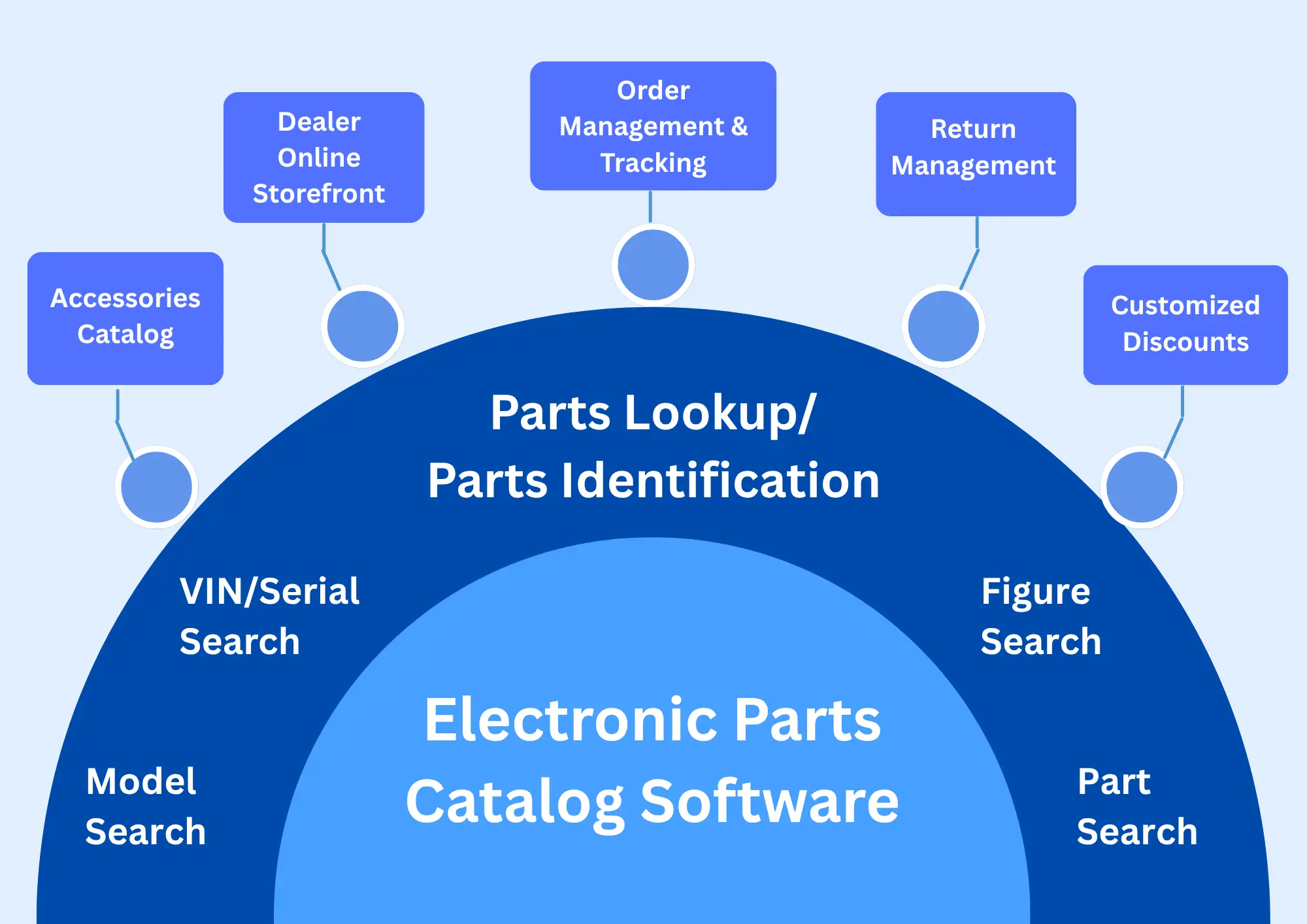
A robust Electronic Parts Catalog (EPC) is the backbone of seamless aftermarket solutions, connecting OEMs, dealers, and customers with precision. At a distressed service bay, technicians keep racing to find a spare part to get a customer’s machine back on track. Technicians at a service bay roll over the EPC, hoping for a quick fix. However, they’re hit with a clunky system that feels like it’s running on an outdated catalog with wrong parts, slow searches, and no practical help.
The result? Frustrated customers, lost sales, and operational chaos. In an industry growing at 7.2% annually, driven by tech-savvy buyers demanding comprehensive parts ordering and tracking, legacy EPCs are a liability. These systems stagger and undermine OEMs’ high-margin revenue streams and market competitiveness. For OEMs in the steering automotive, aerospace, or heavy machinery industries, the stakes are clear: an underperforming EPC erodes profits and trust. Intelli Catalog, a transformative electronic parts catalog software, redefines excellence with AI-driven tools and integrated modules.
This article explores why outdated EPCs fail and how Intelli Catalog’s precision-driven operations empower OEMs to lead, delivering efficiency and growth in a dynamic aftermarket.
The Growing Expectations of Today’s Aftermarket Industry

The aftermarket is no longer a sleepy side hustle for OEMs as it was a few decades ago. Today, end-users, whether it's customers, dealers, or technicians, all want a parts-buying experience as slick as ordering groceries online. Around 65% of B2B buyers now lean toward digital platforms for their speed and ease, demanding instant answers for queries like ‘Is the part in stock?’, ‘What’s the price?’, ‘When’s it coming?.’ Anything less feels like a personal affront. This shift, driven by e-commerce and technological breakthroughs, has rewritten the catalog playbook for aftermarket leaders.
Technology is the rocket fuel here. Artificial Intelligence (AI) delivers searches that practically complete a technician’s thoughts. Mobile applications enable dealers to check stock from a soiled job site. Cloud-based spare parts catalog software syncs with ERP and Dealer Management Systems (DMS), keeping data flowing smoothly. Add graphical 2D/3D illustrations to visualize parts, and the expectations keep rising.
For OEMs who have survived decades of industry shifts, the lesson is clear: an EPC that can’t keep up is a drawback. Modern digital parts catalog systems are built to match this pace, ensuring your business doesn’t get left behind in a cutthroat market.
Common Shortcomings of Legacy Electronic Parts Catalogs

Legacy EPCs may have worked in the past, but they are now terribly out of place. The limitations of these systems are a persistent pain in the side for aftermarket leaders, slowing down operations and decreasing revenue.
Here are the significant drawbacks of legacy EPCs:
Inaccurate Inventory Data
An EPC is a disaster waiting to happen when its inventory data is outdated. Dealers order parts that are not available, triggering backorders or cancellations. It makes the customers frustrated and impedes sales. Modern systems maintain real-time stock data by syncing with ERP and DMS, something that outdated EPCs are unable to do.
Complex Search Processes
Handling a legacy EPC is a difficult task, similar to solving a Rubik's Cube while wearing a blindfold. Particularly for beginners, part searches become a marathon due to layered menus-Model, Year, Subsystem. As mistakes accumulate, the staff's patience fades. Users need tools like AI-driven searches to cut through this chaos.
Limited Integration
Because they are disconnected from e-commerce platforms, ERP, and DMS, old EPCs are essentially eccentric. This forces manual data entry, a slow, mistake-prone chore that inflates costs. A modern EPC software program seamlessly integrates systems and optimizes workflows.
Lack of Parts Supersession Control
When EPCs don't keep track of supersessions, obsolete parts might be a risky proposition. Purchasing a discontinued part results in additional expenses, warranty disputes, and delays. Modern EPC systems keep dealers informed by updating parts supersession data instantly.
Poor Visuals
Catalogs that just include text are no longer sustainable. Without 2D or 3D graphics, technicians make assumptions about parts, which results in misorders. Interactive illustrations with part highlights and hotspots make selecting parts straightforward.
No AI Capabilities
Legacy electronic parts catalogs are outdated and lack AI's power. Functionalities like predictive analytics and natural language search are more of a necessity to match the current aftermarket dynamics. Older configurations lack the speed and intelligence that AI-powered parts cataloging systems provide.
The Impact of an Underperforming EPC on Your Business

An out-of-date EPC is a blow to your business and not simply a bug. For an OEM, the damage cuts deep across profits, operations, and reputation.
Here is how it impacts OEM’s business:
Lost Revenue
When an EPC shows bunk inventory or mislabels parts, orders crash, and your bottom line takes a hit. Customers rush to competitors rather than wait. According to industry data, poor parts management can cut 36% of working capital, a blow that stings any balance sheet.
Operational Inefficiencies
Teams that use legacy EPCs are burdened with manual labor. Without integration, employees spend hours entering data or correcting mistakes, which increases labor costs. These tasks are automated by modern digital parts catalog systems, which might result in a 30% reduction in operating expenses.
Customer Dissatisfaction
Nothing irritates dealers and customers like late or wrong orders. A survey found up to 86% of purchasers ditch the brand after a bad experience. A solid EPC maintains strong connections by delivering orders on schedule and as promised.
Competitive Disadvantage
While your team is stuck in a clunky EPC, competitors with cutting-edge parts catalog systems are taking the lead. They produce orders more quickly, maintain stricter inventory management, and have more satisfied customers. In a market where most buyers crave ease, lagging behind hands market share to the competition.
These stakes make it quite apparent that you have to roll out an underperforming electronic parts catalog. Solutions like Intelli Catalog turn these messes into wins. How? Let’s find out in the next section.
How Does Intelli Catalog Address These Challenges and Future-Proof Your Aftermarket?

As aftermarket leaders, we at Intellinet Systems understand the critical need for seamless aftermarket solutions that empower dealers and deliver directly to customers. The industry’s rapid evolution demands precision-driven operations, but legacy EPCs are flooded with inefficiencies and fall short in the consistently evolving aftermarket. Intelli Catalog redefines aftermarket excellence with AI-powered tools and integrated modules.
Beyond providing complete parts order management and tracking capabilities that streamline processes, these modules also enable OEMs to explore high-margin revenue streams and ensure dealers flourish. From online storefronts to return management, Intelli Catalog equips OEMs with the flexibility to dominate. Below, we outline how its modules deliver unmatched value, ensuring your business transforms into a smoothly operating profit center and leads in a competitive landscape.
Dealer Online Storefronts
Imagine being able to set up a digital shop that functions as smoothly as turning on a button. Intelli Catalog’s dealer online storefronts empower OEMs to deliver seamless spare parts directly to customers. By granting dealers cloud admin access, we facilitate the quick setup of B2C storefronts that are completely functional in a matter of hours. This module integrates seamlessly with parts ordering and tracking with e-commerce platforms. Dealers configure pricing and terms to safeguard margins, with tools to adjust or cancel orders for streamlined fulfillment.
Customers access these portals via dealer websites or OEM zip code searches, enjoying a frictionless journey from browsing to checkout. Real-time ERP and inventory sync ensure accurate stock and pricing, reducing misorders by 20%. Advanced tools simplify packing slip creation and shipping updates and enhance precision-driven operations. For OEMs, this drives high-margin revenue streams, faster sales, happier customers, and strengthens their market leadership.
Order Management and Tracking
Intelli Catalog’s order management and tracking module is a cornerstone of comprehensive spare parts order management and tracking, streamlining dealer workflows with precision. Dealers can add parts from a pre-set bill of materials, pick custom parts as needed, or bulk-import via Excel for large orders. At checkout, they can make adjustments to quantities or add additional items, with breadcrumbs tracking the progress.
The module supports flexible order types, whether it's dynamic or admin-configured, enabling dealers to tailor attributes to their specific needs. Billing is streamlined with locked addresses (which are editable with admin approval) and quick shipping options, including the last five used addresses or autofill for child dealers. Customized shipping methods, determined by parts volume and shipment weight, allow dealers to include special instructions for precision.
Before finalizing, dealers can review all details, including discounts, with admin-set checkout notes clearly displayed. After submission, a unique order number and confirmation ensure seamless communication between dealers and OEMs, allowing dealers to track and manage their orders anytime. Real-time ERP dispatch sync and tailored reports for open orders, backorders, and more provide valuable insights, reducing processing time by 40% and errors by 30%. This enhances OEM efficiency and builds dealer trust.
Accessories Catalog
Our accessories catalog module transforms aftermarket sales by delivering high-margin revenue streams directly to customers. Unlike legacy EPCs that obscure add-ons, this module offers seamless browsing of accessories like lubes or body gear through simplified searches. Enhanced workflows enable dealers to compare items side-by-side, ensuring accurate selections. The Magic Pic AI feature uses smart visuals to pinpoint parts, reducing misorders by 25%. Flexible customer order types and streamlined checkout make purchasing straightforward, syncing with real-time inventory to avoid overselling.
This drives a 10–15% increase in accessory sales, as customers easily add extras during purchase. Utilizing this module to display add-ons, OEMs can notice significant improvements in customer satisfaction and profit margins. By making accessories a seamless part of the buying experience, this module ensures precision-driven operations and a competitive edge to OEMs in a crowded market.
Return Management
Managing returns can feel overwhelming, but Intelli Catalog’s return management module redefines efficiency by turning complex returns into precision-driven operations. Legacy EPCs burden dealers with manual processes, but this module automates submissions, tracking, refunds, and replacements via an intuitive portal. Barcoded packing lists enhance visibility, making tracking orders simpler than ever. Convenient shipping is guaranteed by a smooth integration with FedEx, UPS, and TNT, and dealers are kept informed with real-time status updates. OEM administrators authorize configurable policies and efficient approval workflows for control and speed.
Data-driven insights identify return trends and enable process improvements. Inventory integration ensures accurate restocking and helps minimize losses. This reduces processing time by 50% and errors by 35%, helping OEMs cut costs by 20%. For OEMs, this module strengthens dealer trust and delivers end-to-end parts order management and tracking for a future-ready aftermarket.
Customized Discounts
Intelli Catalog’s discounts module is a strategic tool for driving high-margin revenue streams through tailored promotions. Due to the dependence on human adjustments, legacy EPCs falter with error-prone manual discounts. To overcome such struggles, this module automates special programs to boost sales. A virtual parts and accessories fair engages dealers and customers, amplifying conversions. Flexible discount parameters enable OEMs to craft seasonal, bulk, or loyalty deals with precision, protecting profit margins.
A streamlined dealer experience simplifies applying discounts, reducing checkout obstructions. A dedicated checkout for special program purchases ensures accurate pricing and seamless transactions. The system tracks how discounts perform, giving OEMs data to sharpen their strategy and boost ROI. For OEMs, this translates into happier dealers, more satisfied consumers, and fewer price blunders. This module empowers OEMs to deliver discounts seamlessly in aftermarket services, fostering dealer loyalty and customer satisfaction in a deal-driven market.
Conclusion
Running an aftermarket with outdated electronic parts catalogs is like trying to win a sprint where a single misstep can lead you to lose customers’ trust. In a $2.3 billion market charging toward 2032 at 7.2% annually, legacy systems choke on errors and delays, eroding high-margin revenue streams and turning customers away.
Intelli Catalog shifts the archetype, delivering seamless aftermarket solutions through AI-powered searches, ERP/DMS integration, and robust modules for storefronts, orders, and returns. Its complete order management and tracking empowers dealers to serve customers with precision, driving loyalty and growth. OEMs shaping this industry must act decisively: modernize with Intelli Catalog to secure precision-driven operations and market leadership.
Talk to our industry experts and take a demo to steer your aftermarket toward a future where efficiency and profitability reign supreme.
Explore More Insights
About the Author
Chandra Shekhar
Chandra Shekhar is the Senior Manager, Strategy & Business Development at Intellinet Systems. With over a decade of experience in the automotive industry, Chandra Shekhar has led digital transformation and aftersales strategy initiatives for OEMs across multiple markets. His background combines deep industry knowledge with a practical understanding of how technology can solve real operational challenges. He focuses on making complex ideas clear and relevant for automotive and aftermarket professionals navigating ongoing change.


























